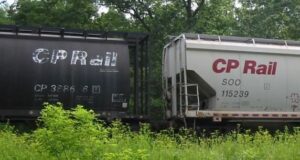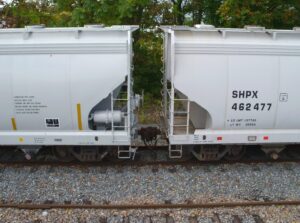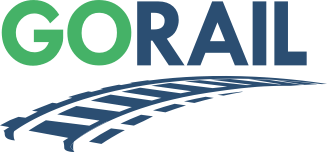Washington, D.C. — When passing a train, you may notice a wide variety of writing on the side of railcars or locomotives; a combination of numbers, markings, and bold letters reading something like “ABCX.” These are called reporting marks, and they are crucial to keeping order among the more than 1.6 million railcars operating across North America.
These marks are two-to-four-letter alphabetic codes, paired with a number of up to six digits, stenciled on every railcar or locomotive to uniquely identify ownership of the car or locomotive and track its movement across the rail network.
Who Assigns Reporting Marks?

Reporting marks are assigned by the Association of American Railroads (AAR) under authority from the U.S. Surface Transportation Board, Transport Canada, and the Mexican government. The maintenance of these codes is managed by Railinc, a subsidiary of AAR that serves as the rail industry’s primary resource for equipment health and real-time rail data.
The system has a consistent structure:
- Marks often begin with the initial letters of the railroad (e.g., CSXT for CSX Transportation).
- The final letter indicates ownership type:
- X = private car owners (e.g., EDSX for Exxon, since it is not a common carrier)
- U = intermodal containers (e.g., MAEU for Maersk)
- Z = trailers used in rail transport (e.g., UPSZ for UPS)
Railroads usually abbreviate to their initials or end in a “T” for “Transportation,” such as CSXT. Others use simple identifiers like “UP” for Union Pacific, “BN” for BNSF, or “NS” for Norfolk Southern. Short lines also follow this system; for example “DCR” for Delmarva Central Railroad or “WN” for the Wisconsin Northern Railroad.
More Than Just Letters

These identifiers do more than mark ownership. They are central to the tracking and interchange systems that enable rail cars to move seamlessly between different railroads, helping ensure efficiency, transparency, and reliability for customers.
Reporting marks can also preserve a sense of history. When one railroad acquires another, it often keeps the legacy marks of the acquired company. For example, after Union Pacific absorbed the Chicago & North Western, the CNW mark remained in circulation. More recently, following Canadian Pacific’s 2023 merger with Kansas City Southern (to become CPKC), you can still see KCS marks in use.
Why They Matter
Though compact, reporting marks carry deep significance—for railroads, private car owners, and shippers as well as railfans and stewards of rail history—supporting seamless supply chains while preserving railroading heritage.
To learn more about how America’s freight rail network operates, visit our Rail 101 page for a deeper look at the systems and technology that keep goods moving efficiently.


